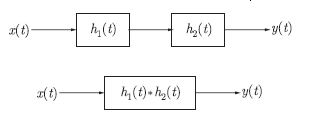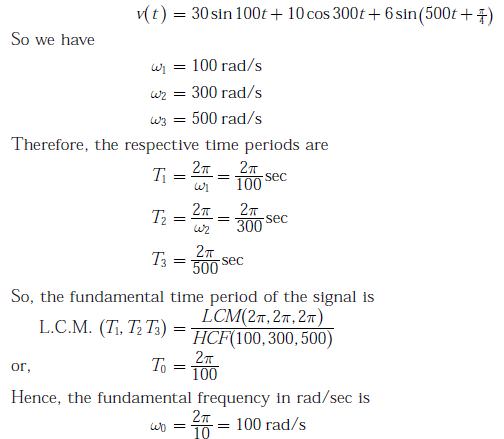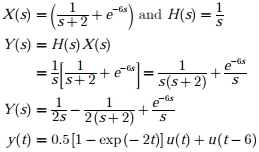Signals and Systems - Online Test
Q1. Let x(t) be a continuous time periodic signal with fundamental period T = 1 seconds. Let {ak} be the complex Fourier series coefficients of x(t), where k is integer valued. Consider the following statements about x(3t):
I. The complex Fourier series coefficients of x(3t) are {ak} where k is integer valued
II. The complex Fourier series coefficients of x(3t) are {3ak} where k is integer valued
III. The fundamental angular frequency of x(3t) is 6𝜋 rad/s
For the three statements above, which one of the following is correct?
Answer : Option B
Explaination / Solution:
Fourier series coefficient ak is unaffected by scaling operating. Thus (I) is true and (II) is false.
T = 1sec for x(t) and if it compressed by '3' then the resultant period T = 1/3
Fundamental frequency = 2𝜋/T1= = 6𝜋 rad/sec
Thus (III) is correct.
Q2. The result of the convolution  is
is
 is
is
Answer : Option D
Explaination / Solution:
From the convolution property,



Now, we replace t by -t to obtain

Q3. A discrete time signal x[n] = sin (π2n) n being an integer, is
Answer : Option D
Explaination / Solution:
In the given options (A), (B) and (C), we have the periods respectively as
N1 = π
N2 = π2
N3 = π/3
None of the above period is an integer. Since, a discrete time signal has its period
an integer. So, all the three options are incorrect. Hence, we are left with the
option (D). i.e. the discrete time signal x[n] = sin (π2n) is not periodic.
Q4.
Two systems with impulse responses h1(t) and h2(t) are connected in cascade. Then the overall impulse response of the cascaded system is given by
Answer : Option C
Explaination / Solution:

If the two systems with impulse responseh1(t) and h2(t) are connected in cascaded configuration as shown in figure, then the overall response of the system is the convolution of the individual impulse responses.

Q5. For a periodic signal  the fundamental frequency in rad/s
the fundamental frequency in rad/s
 the fundamental frequency in rad/s
the fundamental frequency in rad/s
Answer : Option A
Explaination / Solution:
Given, the signal


Q6. A system is defined by its impulse response  The system is
The system is
 The system is
The system is
Answer : Option B
Explaination / Solution:
No Explaination.
Q7.
Assuming zero initial condition, the response y(t) of the system given below to a unit step input u(t) h is
Answer : Option B
Explaination / Solution:
The Laplace transform of unit step fun n is 



U(s)=1/s
So, the O/P of the system is given as

For zero initial condition, we check


Hence, the O/P is correct which is

its inverse Laplace transform is given by
Y(t)=tu(t)
Q8. If the unit step response of a network is (1 – e-αt), then its unit impulse response is
Answer : Option A
Explaination / Solution:


Q9. An input  is applied to an LTI system with
impulse response h(t) = u(t). The output is
is applied to an LTI system with
impulse response h(t) = u(t). The output is
 is applied to an LTI system with
impulse response h(t) = u(t). The output is
is applied to an LTI system with
impulse response h(t) = u(t). The output is
Answer : Option D
Explaination / Solution:
 and h(t) = u(t)
and h(t) = u(t)

 and h(t) = u(t)
and h(t) = u(t)Taking Laplace Transform we get

Q10. Which one of the following is an eigen function of the class of all continuous-time, linear, time-invariant systems u(t) denotes the unit-step function)?
Answer : Option C
Explaination / Solution:
No Explaination.
